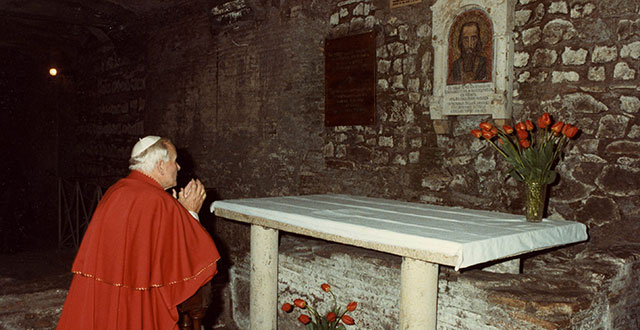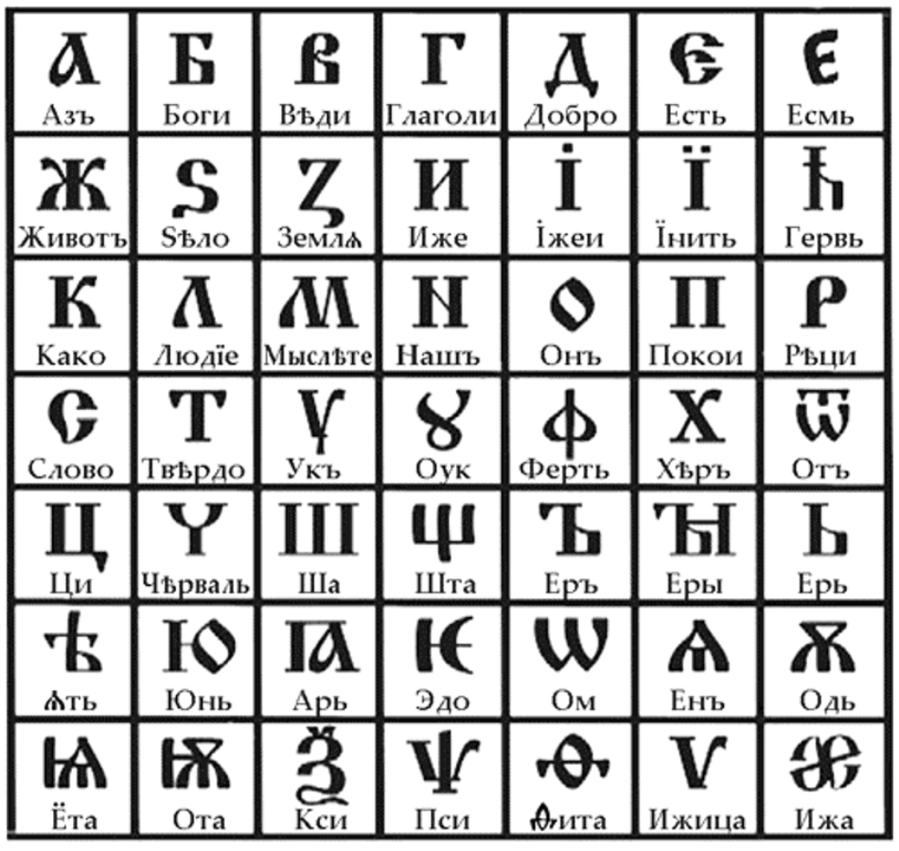
The two brothers Cyril and Methodius, sent to Rome as missionaries among the Slavs in Moravia by the Byzantine emperor Michael III, met Pope Hadrian II at the beginning of the year 868 in the Basilica of Santa Maria Maggiore: “The pope welcomed the Slav books, consecrated them and laid them in the church of Santa Maria, which is called Pathne “*.
Cyril and Methodius had brought to Rome, as a gift to the Pope, the remains of St. Clement, which had been found in the Crimea.
Rastislav, prince of Great Moravia (the first Western Slavic state), in the year 863 with the intention of freeing himself from the increasingly pressing Franco-Germanic interference and the coercive power of the German clergy, induced therefore by strong political reasons even before religious ones, turned to the emperor of Byzantium, Michael III, to send missionaries capable of evangelising the Slavic people in a language immediately understandable to them, thereby encouraging the rise of Slavonic to a language of worship, alongside Latin, Greek and Hebrew – the only languages officially permitted at the time for preaching and for any activity connected with worship.
Unfortunately Cyril fell ill, became a monk in Rome (until then his name was Constantine) and died on 14 February 869. As a form of gratitude on the part of the Pope he was buried in Rome, in the Basilica of San Clemente, which also houses the remains of the saint of the same name.
Cyril and Methodius were born in Thessaloniki, in the region of Thessaly, in an area characterised by the use of Greek by the dominant class for administrative and religious matters and by the use of ancient Slavic, a language that circulated only in oral form and which it was up to Cyril and Methodius to formalise and construct through the elaboration of an alphabet: the Glagolitic alphabet. The 24th May 855 AD is a date of significant historical and cultural importance for the whole Slavic world, commemorating the birth of the first Slavic alphabet and the first Slavic language in written form, the basis for the development of subsequent national literatures.

Beato Giovanni Paolo II, Egregiae virtutis (31 dicembre 1980)
Cyril, known as “the Philosopher” for his profound and eclectic culture, was a connoisseur of many languages and various alphabets. In addition to Slavonic, he was fluent in Latin, Greek, Hebrew, Arabic and Khazaro. He developed the first Slavic alphabet (called Glagolitic – from “glagol”, “word, verb”), made up of about 40 letters, thanks to which the Slavic phonetic system was reproduced in an extremely precise way, with an extraordinary correspondence between grapheme and phoneme, that is to say graphic sign and its pronunciation, much better than the Latin or Greek alphabets, with only a little more than 20 letters each.
The aim of the Byzantine Emperor Michael III is clear: to evangelise the people of Moravia with the help of experienced monks who could spread the verb in ancient Slavic. Cyril and Methodius, however, went further and translated the sacred scriptures into ancient Slavonic, going so far as to affirm the autonomy of the Slavonic in relation to the predominant position of Latin and Greek. This audacity caused conflicts with the Latin and Greek components of the ecclesiastical hierarchies. In any case, the Glagolitic alphabet is the first reference alphabet of ancient Slavic.
After the death of Methodius, the disciples of the two brothers will develop a simpler alphabet, whose basis is the Greek alphabet, supplemented by letters that better represent the sounds of the ancient Slavic language.
The two brothers, venerated as Saints indiscriminately by Catholics and Orthodox, having performed this important function of spiritual and cultural bridge between the Western and Eastern Christian tradition, pregnant with implications on several levels, were proclaimed co-patrons of Europe by Pope John Paul II in 1980.
Cyril was the creator not of the more commonly known alphabet that bears his name, but of a more complex alphabet, decidedly less decipherable in form: the Glagolitic. According to the opinion of most scholars, the Glagolitic is based on different alphabets, of which Cyril had full mastery, such as the Latin, Greek, Hebrew, Ethiopian, Coptic, Georgian, Armenian alphabets, to which even alchemical and astronomical signs and Bulgarian runes should be added. One wondered why Cyril had drawn on so many sources, among other things so different from each other, when he could more easily have based himself on the two most common alphabets, Latin and Greek. Well, for doctrinal and liturgical purposes, Cyril would have purposely conceived a completely new alphabet, with which he could represent the Slavic language in written form, so that this language, considered “barbarous”, starting from the alphabet itself, would not find itself in any relationship of subjection towards the other languages (and therefore cultures) then considered “sacred” par excellence (Hebrew, Greek and Latin) and could instead compete with them as soon as possible on a level of absolute equality and from every point of view, both liturgical-sacral and cultural prestige in the broadest sense.

The ancient Cyrillic alphabet was fundamentally based on the Greek alphabet, from which all those letters that could well represent the existing sounds even in the Slavic language were drawn.
In the course of time, two important spelling reforms were initiated, which led to the abolition of all those letters that no longer corresponded to real sounds (for example, the letters that represented nasal sounds that were once actually pronounced – among modern Slavic languages they have been preserved in Polish). In particular, a first reform was carried out in the years 1708-1710, ordered by Peter the Great (defined as the civil alphabet), which also required a change in the typeface of the letters, which were more stylised and rounded according to the style then in vogue in the West for Latin letters. The second reform, aimed at further simplification, took place during the years of the October Revolution, in 1917-1918. From the more than 40 original graphemes, therefore, the 33 letters of today were progressively replaced by the 33 letters of today. However, the ancient Cyrillic alphabet remains current in order to understand, for example, the inscriptions on icons.

The pagan Slavs from the 6th century onwards seem to have used, for divination or calculation purposes, a code of about 130 signs, the Bulgarian runes, and had already made attempts to write their language in Greek and Latin characters, but in vain, precisely because of the difficulty of representing certain specific sounds of their language, as testified by the monk Chrabr in his famous treatise on letters, dating back to the 10th century).
*Source: Introduction to the early Slavic language, Nicoletta Marcialis, Firenze University Press 2005.
*History of the Cyrillic alphabet by Antonio DeLisa 2018
The Rome Central – Italy in the world editorial staff consists of freelance editors, journalists, photographers, filmmakers, doctors, writers, video-makers, supporters, poets, writers, actors, singers and many friends.
RomeCentral is a Magazine completely no-profit , whoever writes in this magazine does his job without any commercial pressure.
NB: No people in Rome Central, from managers to employees etc .., receive any type of compensation.
The love for the free journalism repays all our efforts.
